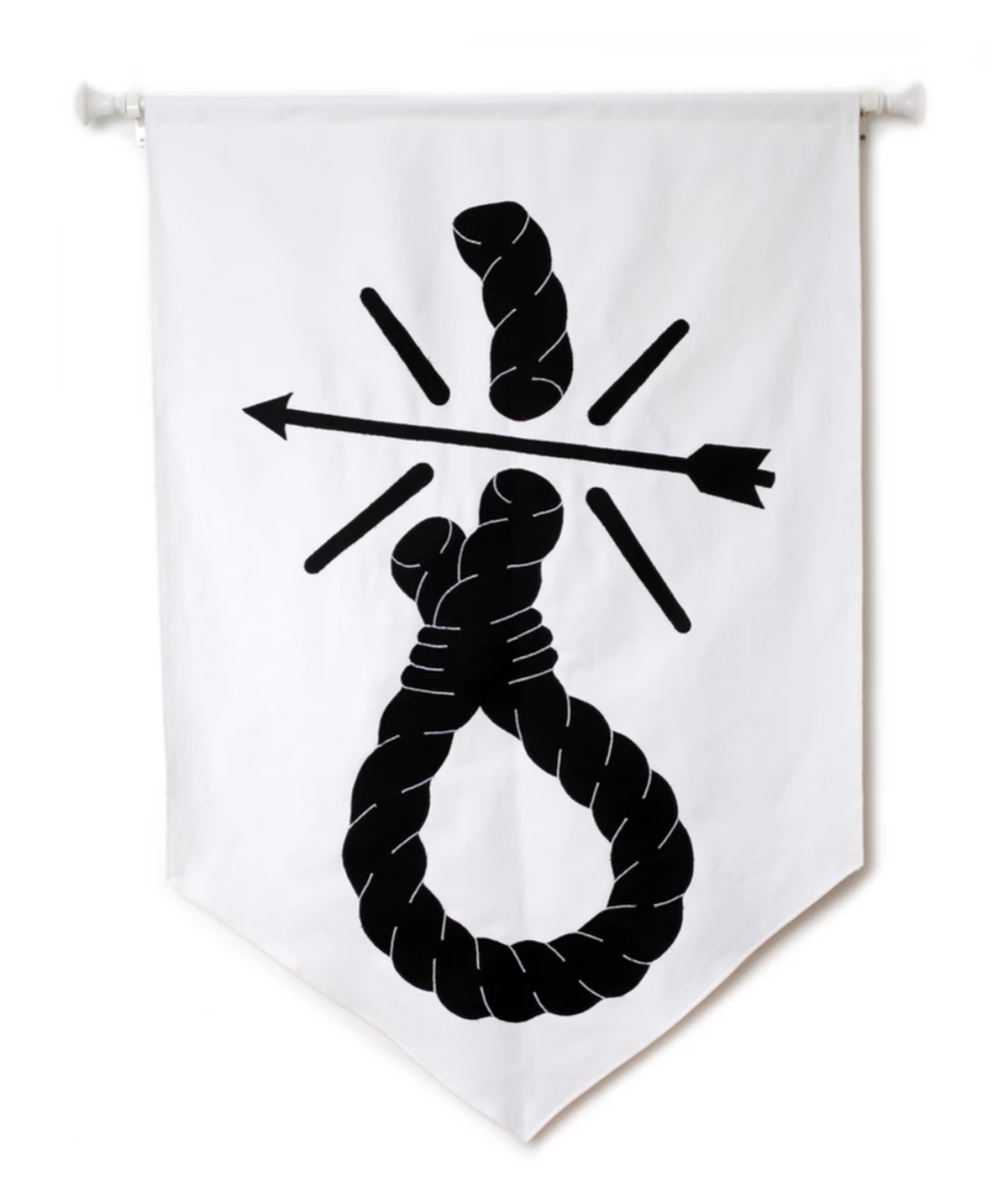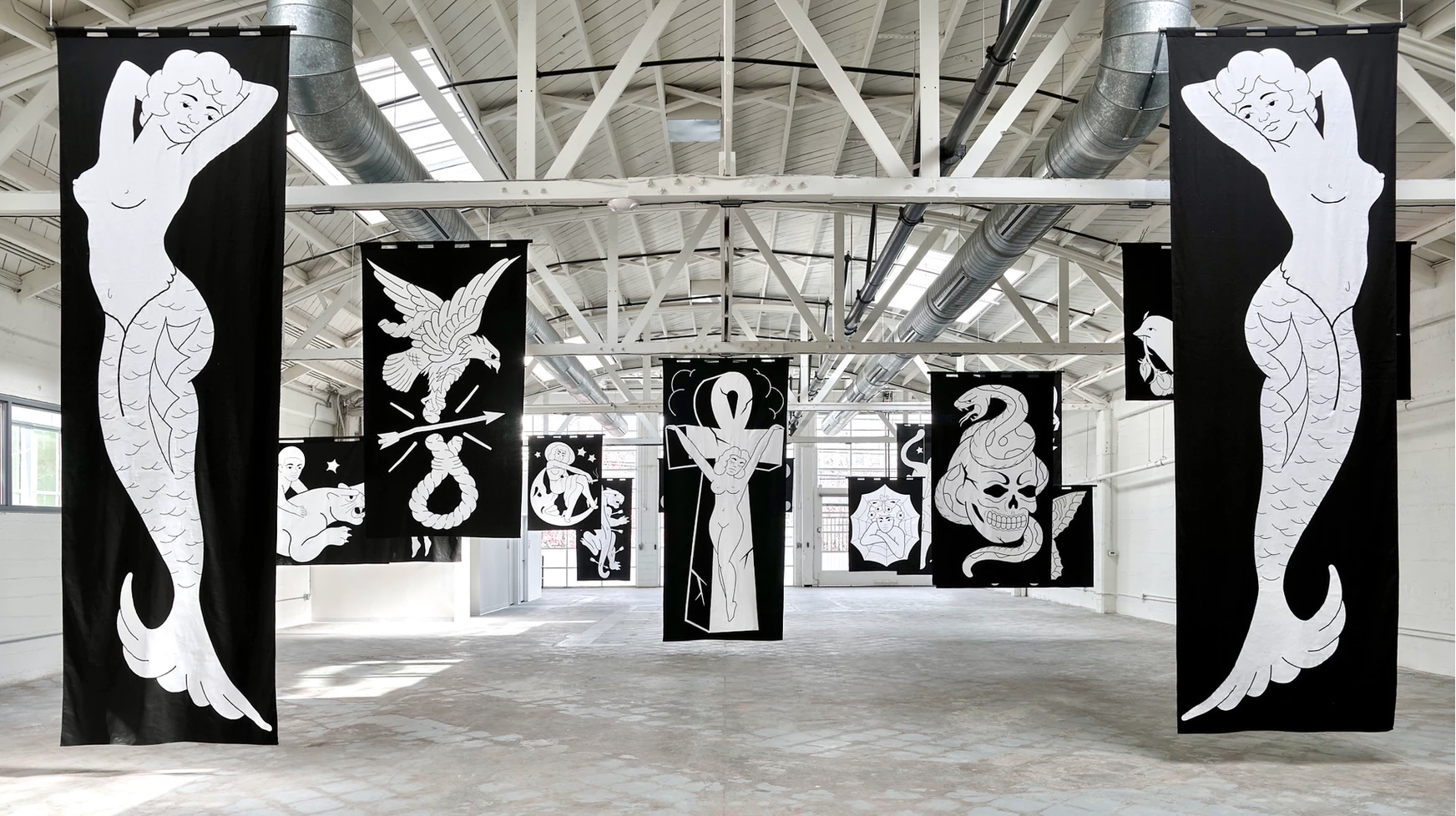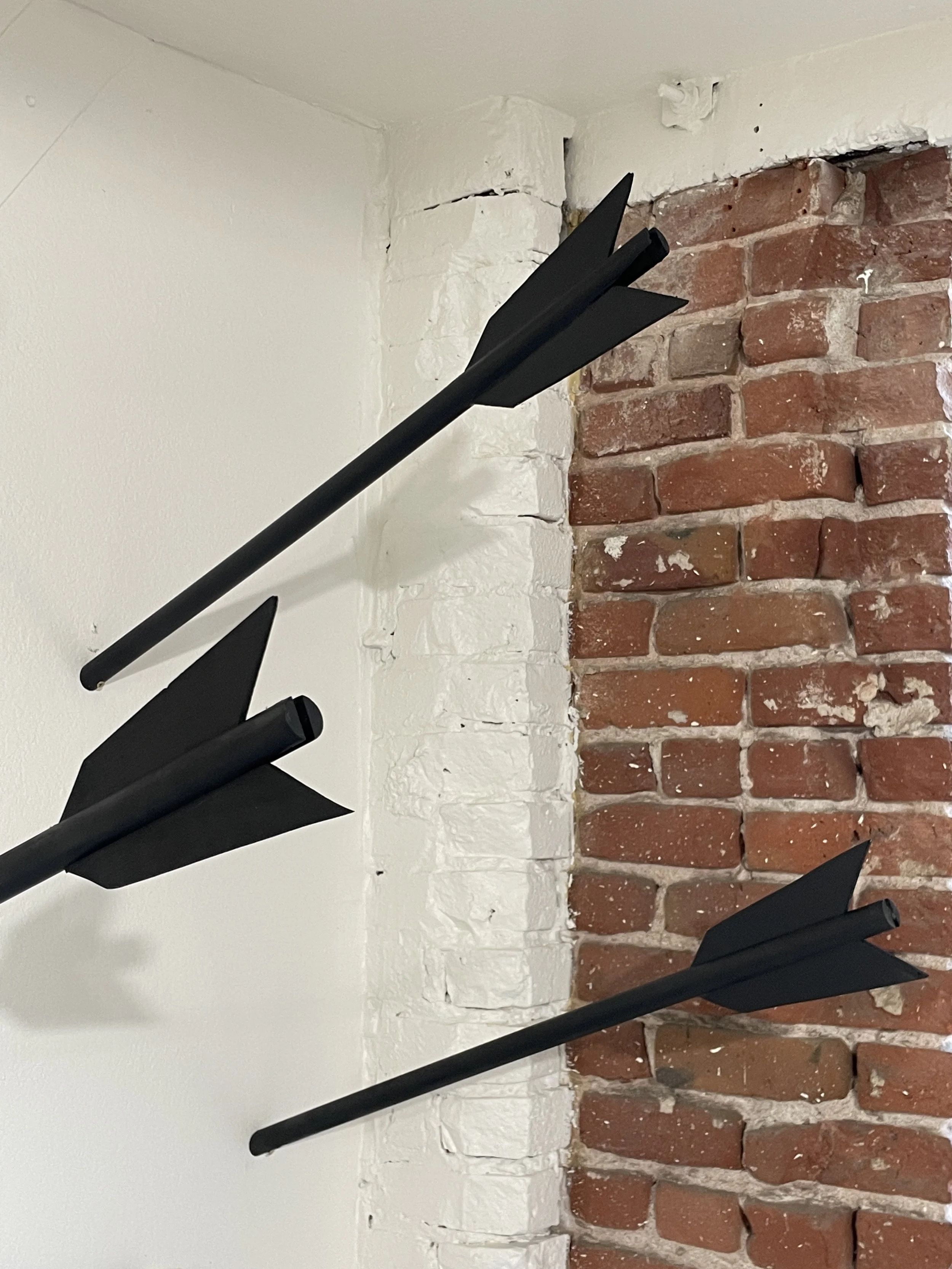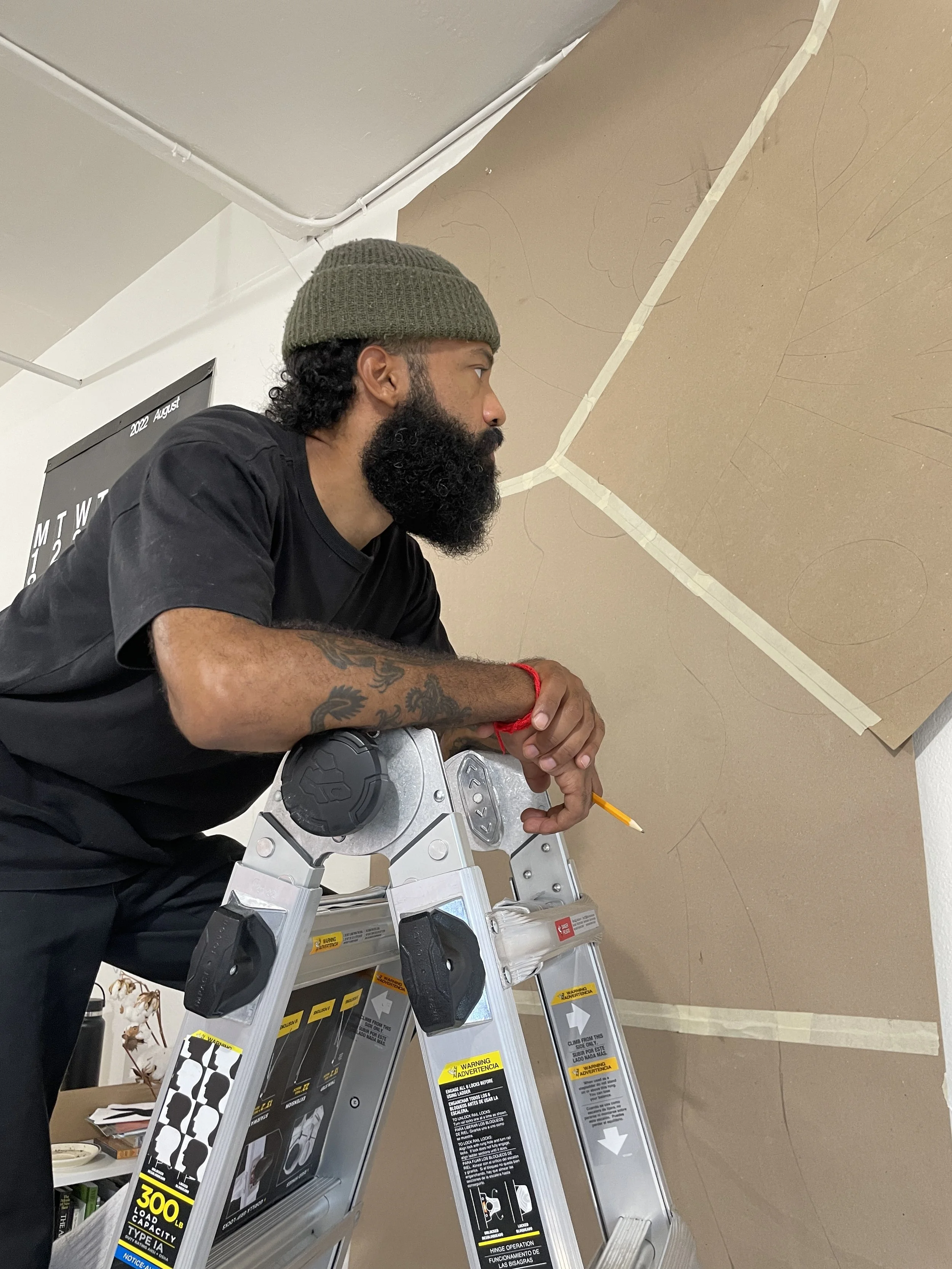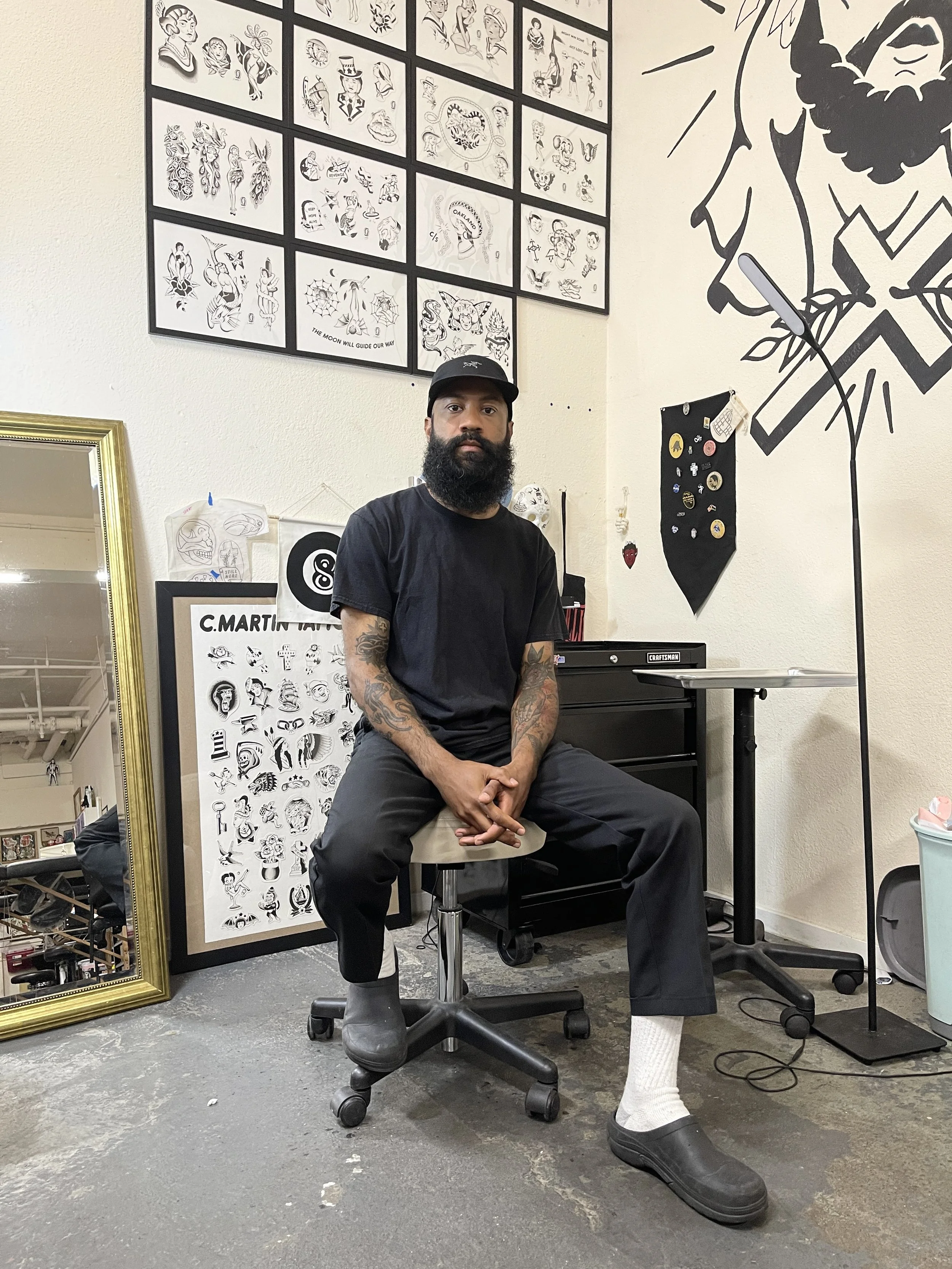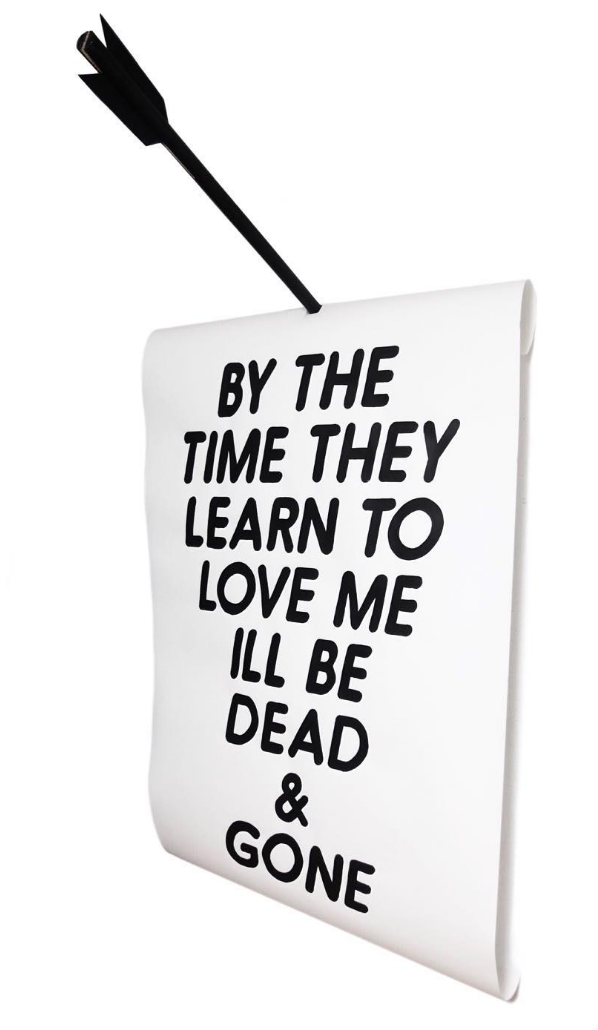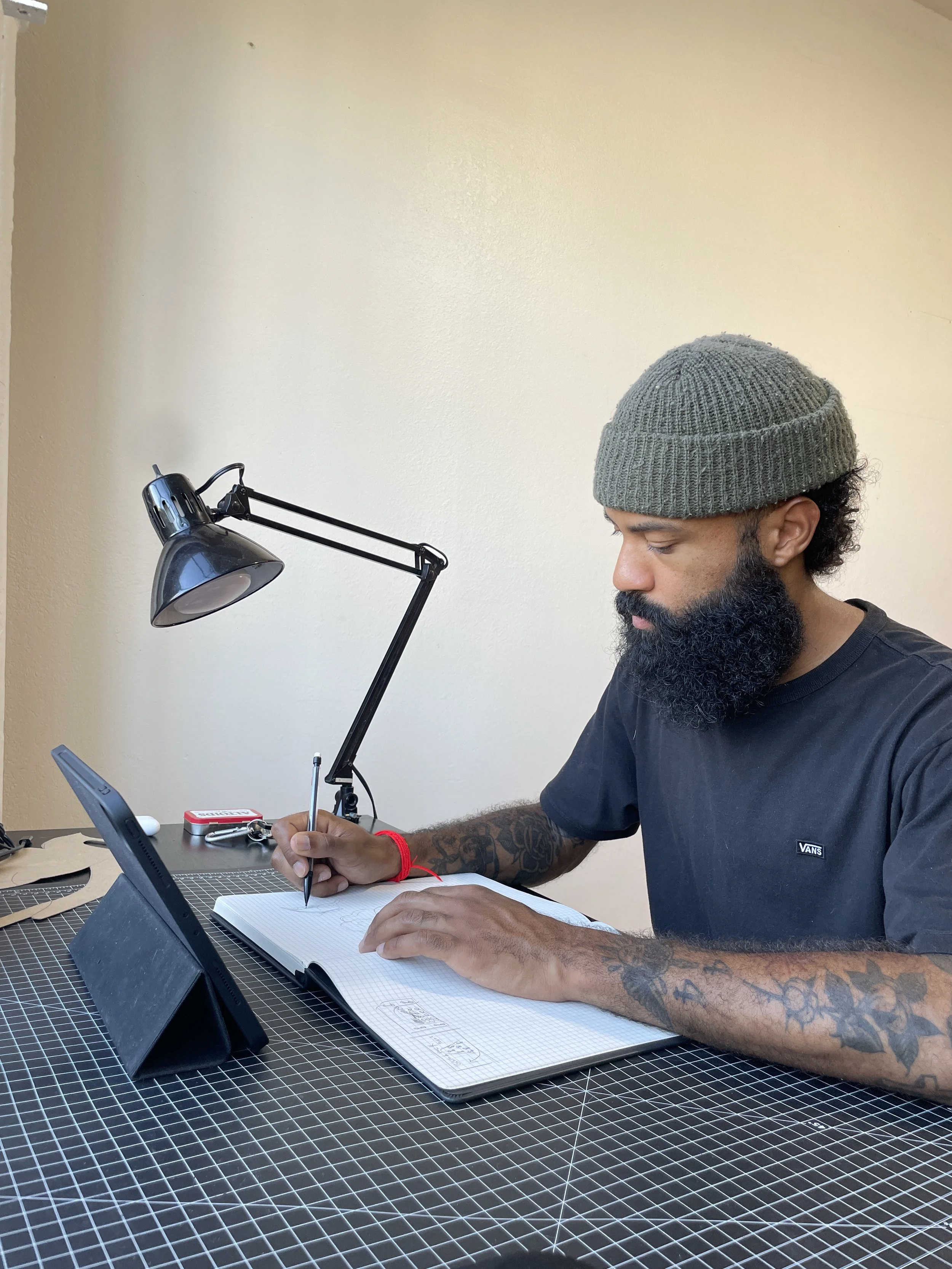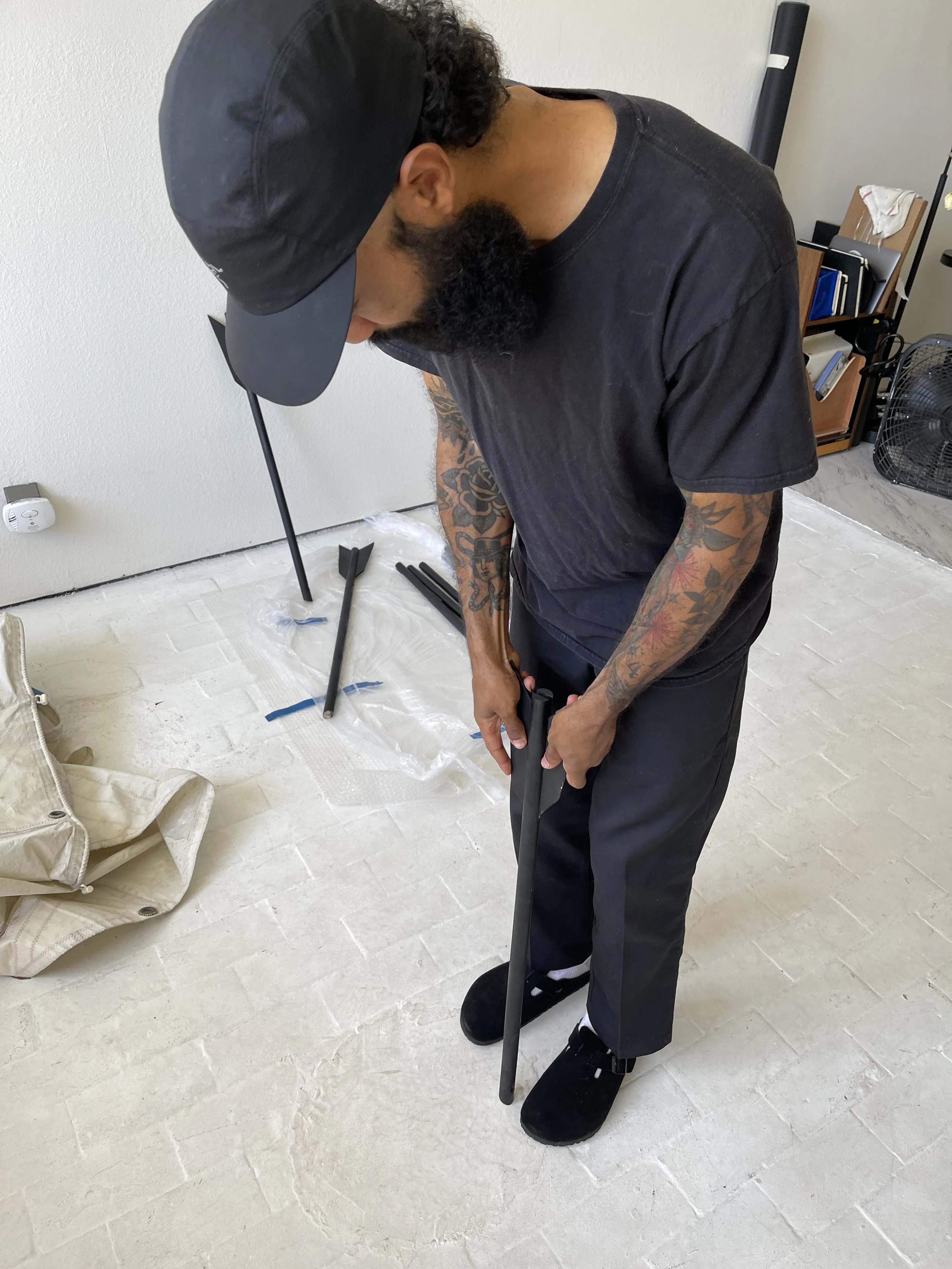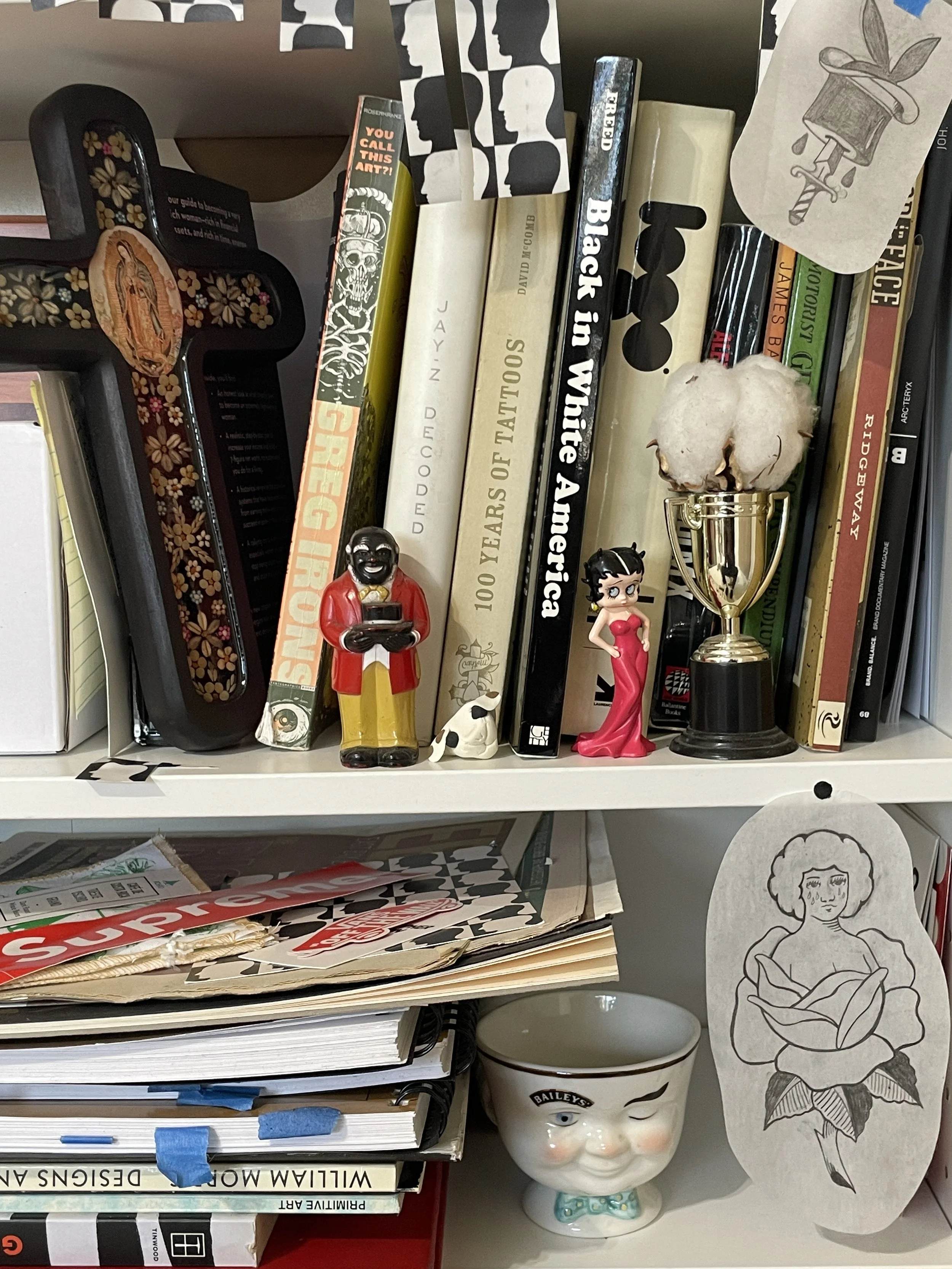Studio Visit & Interview with Christopher Martin
By John Vochatzer
Chris Martin is someone who’s momentum over the past few years has been as amazing as it has been inspiring to witness. In both idea, execution, and the sheer potency of the messages conveyed in his work, I can’t think of a single other artist working on such an epic scale right now. Most recently this level of scope and vision was on full display at the new Institute of Contemporary Art in San Francisco, where Chris took over and activated the entirety of the space earlier this year for their inaugural exhibit. And this was only the latest achievement in a succession of many that have culminated in Chris becoming one of the most preeminent creative forces in the Bay Area as we speak.
A multi-hyphenated artist, apart from his studio and installation art practices, Chris also does work in the fields of clothing design, tattooing, and musical production—just to name a few—and both stylistically and thematically he never fails in seamlessly tying each of these mediums together. His work embodies the “less is more” credo in terms of design, most often with a simple yet resounding black and white palette and words and imagery reduced down to their bare, integral cores. As minimal as it is, there’s an intense lyricism that lay at the heart of all of it—at times hopeful, at times melancholic, but always crushingly powerful.
“Cheat The Gallows” hand-sewn banner.
In 2018, Chris began his journey into the world of tattooing which has since carried over into the rest of his art practices—with his traditional Americana inspired flash designs working interchangeably as hand-sewn icons on flags and banners used in his installations. Often accompanied by single lines or sentences taken from songs or other sources and then recontextualized, Chris similarly reappropriates tattoo motifs and imbues them with the traditions and histories that have been undermined and even extinguished in white supremacist America. The banners themselves, which employ cotton as their primary medium, in the material itself pay homage to these histories and to the individuals who lived and died throughout their course.
At the end of the day, Chris’s overarching vision and ethos as an artist, and all its outlets therein, has come together to form an ongoing body of work that is not just powerful, but utterly vital and necessary. It is art that confronts what must be confronted, but always does so with unflinching grace. And with that I can think of no one more deserving of all the successes he’s earned and all that he has to look forward to.
Interview
Hey Chris! It was great catching up and hearing about all the amazing stuff you’ve had going on lately. Most recently you just wrapped up an epic exhibition “Ancient As Time” that happened to be the very first show at the new SF Institute of Contemporary Art. Can you tell us a little bit about this exhibit and how it came together?
Really appreciate you taking time to swing by the studio! Congrats with everything you’re doing with the gallery. The museum reached out initially to collaborate on a temporary logo for their organization. They wanted an identity that could be used to make a statement before opening and build awareness during the FOG art fair. Eventually, I landed on the idea of utilizing my arrow and note design. The final image was of ICA as notes punctured by my arrow motif along with a cherub. The general theme of the design was to convey “we’re coming.” After that it snowballed into them asking me to open the museum with an exhibition and without hesitation I agreed. The building consists of two main rooms, with the first room being a continuation of the logo design, scattered with 100 hand made arrows punctured into the walls alongside 3 large soft sculptures in the center. While the back of the museum occupied 16 cut and sewn tapestry banners scattered from the ceiling.
From the exhibit “Ancient as Time” at the Institute of Contemporary Art in San Francisco, January 2022.
It was interesting hearing you talk about your approach to designing your exhibits specific to each location. What are some of the biggest joys and challenges of working like this and creating these large-scale immersive installations? And if given the opportunity, what types of spaces would you like to take over and activate with your work?
I’ve always had the urge to make larger works so when I was presented the opportunity to show my art at the museum, I definitely wanted to take advantage and really show out. Before I take any ideas to paper I have to know what are my limits with space. Knowing that I essentially had no limits was the best feeling ever but equally intimidating because it's all on you to fill this void – not to mention I really only had about 4-5 months to bring this to life.
Hand-made arrows used in Chris’s installations.
The biggest challenge with any show I start is the theme. All of the mental leg work is 70% of what I do that consists of research, spatial mapping, and ideation. The last 30% is the easy part. Basically making art. Don't get me wrong, the production of the work is still time consuming, but none of it really matters if the theme is off. The biggest joy comes from seeing an idea come to life better than what you imagined. If given the opportunity, I would gladly love to do a large sculpture for a public park or space outdoors, something that lives in nature. Exhibitions come and go so fast and often. Which is why I love the idea of my creations being viewed year round as public art.
Although very minimal in both palette and design, your work is incredibly impactful and especially so when done on such an enormous scale. What kind of experience are you hoping for your audience to take away from these installations?
I'm more focused on what I'm willing to leave behind. Every artist has a unique story to tell with a style or craft to represent that. I'm just doing my best to pay respect to my ancestors while adding a modern twist. Ultimately I'd love to leave the audience with a feeling of some sort, be it good or bad with all of the work I create.
“Lady in Spider’s Web” hand-sewn banner.
You also compared your approach to creating exhibits to that of tattooing, at least in regards to working within a certain set of contours and boundaries. Can you tell us a little bit about your journey as a tattooer, and how does your tattoo work tie into your fine art?
When I first moved to the bay I was really taken back by the culture of tattoos here because of the strong community. Like any passion or interest, there are always doors that open along the way. I was quickly influenced by the style of American traditional tattoos and how they’re iconic, bold and simplified. It resonated from my background in graphic design in that the ability to communicate an image with the least amount of lines possible. Later on I got an apprenticeship then the rest was history.
Wall of Chris’s tattoo flash art.
For the longest I took the history of this Americana tattoo imagery for granted, however I found myself making a lot of connections to it within my work. For example an anchor tattoo, most wouldn't think much of a sailor with an anchor tattooed on their arm. But when I started diving further into the history of these mementos and the meaning, they had spoken volumes to my personal art practice. Something so simple like an anchor was a badge symbolizing passage across the Atlantic ocean. You could literally tell a person's life story at sea and their accomplishments from voyages.
At this point I found myself connecting the dots: combining the story of the African Diaspora and sailor tattoos. The conversation of two completely different types of people crossing the same body of water in opposite directions. But still finding commonality within the two narratives. I'm always finding a way to piece together the larger puzzle. Making the art physically is pretty easy or straightforward for the most part, but what takes up most of my time is the story and history of what I want to portray.
When I was asked to do the exhibition for ICASF, there was an idea of the art that I wanted to make but no clear vision of how to display it all. I knew I wanted a banner in the center, and 2 mermaids to greet the viewer as they entered but that was it. I originally wanted to hang the work against the wall like I've typically done in the past but with the museum being remodeled with concrete walls and pipes blocking most of the surface it was clear that my best option was to hang my banners from the ceiling, which made the world of a difference in how my work is viewed.
Since this was my first time working with a space of that size, I wanted to be sure the flow was on point with how the audience walked through the space. I finally came to the conclusion that because the work is inspired from tattoo art that I should go about the same process as my tattoo practice similar to how I would look at the body's anatomy to assess where a certain tattoo design should go or designing a flash sheet, I basically applied that same mentality to the curation of the banners, by making sure the images are staggered and at different eye levels to keep the viewer engaged revealing more as you wondered further into the space.
Located conveniently in the same building as your art studio, can you tell us a little bit about your private tattoo studio “Tres Leches” and the community there?
Chris in his tattoo studio Tres Leches in Oakland, CA.
Tres Leches is a business birthed from the pandemic and is a community of qtbipoc tattooers who do what they love alongside each other. A lot of us were working at shops that didn’t necessarily give us what we needed, nor make our clients feel comfortable so we decided to band together and open our own space. Ultimately it's a shop that allows qtbipoc tattooers to work and grow while offering all clientele the ability to share space with us. It's not a typical walk-in shop so don't go around Oakland looking for a “Tres Leches Studio” sign. It's not that vibe. Being a private tattoo space gives us the comfort to work with whoever we want and not the other way around. Ultimately, we're all there to put on great tattoos while feeling comfort with one another.
On top of making art that draws on a lot of influence from music and song lyrics, you also produce some music yourself on the side. How would you describe the relationship of music to your work? And how do the creative acts of making visual art and making music compare and contrast for you?
“Dead and Gone” ink on paper.
In the earlier years of my work, I dissected and analyzed the blues and have a lot of those lyrics within my work. I love the genre and would listen to it often when creating. It was another layer to my practice. Using the materials of cotton and listening to that music just felt right. Later, I found myself shifting over to hip hop for more lyrical inspiration. The same feeling resonates with a similar story that I could identify with. I've been a musician since about 16 years old but never really took any of it seriously since it was mostly just a hobby. There's something about playing an instrument– an instant gratification. You play the note and it hits you a certain way. No sketching or research or all of the other mental stuff that slows down the creative process. When I create my work, there's a feeling and energy to it. I don't just see the art for what it is. I can also hear the vibes. So in a way I'm kinda producing sounds that mirror the feeling of the artwork. Similar to how a musician scores a film. The visuals inform the conductor what to do and what instruments can make this motion picture breath new life. I'm not too sure if my art compares or contrasts music. It's all the same to me and they all inform each other in a special way.
As someone of whom music is a very important part of their life and creativity, who are some contemporary musicians or songwriters with voices or messages right now that you think should be heard?
I'm a major fan of The Alchemist. The way he produces music is magic. It's this dark surreal tone that comes through the speakers. Or it could be a dream-like approach. Pure magic in the best way possible. I have rituals for when I listen to a new album produced by him. Second would be Madlib. I might get in trouble from the OGs for putting him in second place but it's basically a tie. Third would be Adrian Young. As far as messages to be heard I'd say Quelle Chris has a lot of fresh perspectives untapped within hip hop. His style can be a little avant compared to most but if you can take the time to listen you'll discover some interesting lyrics. Navy Blue, Nappy Nina, Freddie Gibbs, Roc Marciano, Griselda, Tyler, Isaiah Rashad, Danny Brown, and the Bruiser Brigade, Pink siifu, Nickelus F, Curren$y. I mean the list goes on.
Can you tell us a little bit about this car you made for the SF Moma soapbox derby? Had you ever built something like that before? And what’s the story with this giant sail you’re working on?
I've never attempted to make anything like a soapbox derby car before. I made a lil toy car that I raced down a small slope back in my cub scout days but that's it. The original sketch me and my manager Suzette Lee came up with was of a boat. After doing research we found out the original derby car body is similar in shape to a boat. So I ordered all of the parts, assembled it, then found a creative way to build out a sail.
The sail for Chris’s soap box car in SF MOMA Soapbox Derby.
Coincidentally a few of my friends who just acquired a boat asked me if I wanted to put some art work on the sail. It's honestly been a dream of mine to do for the longest and without hesitation agreed. Because there's no deadline I'm taking my sweet time with it and plan on utilizing it in a short film I'm producing along with original scored music.
Any other projects happening right now or coming up that you’re particularly excited about?
It's been a really hectic past couple of years and I'm grateful to say that I'm in a place of rest, reflection, reading, conversing, etc. I have a solo show in May 2023 with Hashimoto Contemporary but in the meantime I'm really looking forward to passion projects.
With a spread in Juxtapoz Magazine, a collaboration with Vans, and a few major exhibits in the past couple years, the trajectory you’re on is pretty remarkable. You say it feels like you’re just getting started; what do you envision next on your path as an artist? What new levels would you like to be bringing your work to?
I've heard that you have to work really hard for at least 10 years to become “an overnight success.” Honestly, I just have this urge of making bigger and better work, with each show or collaboration feeling like a new stepping stone. I've got ideas to last me for years, but that all changes with the project or space presented. However, I'm not just sitting around in my studio cranking out work all day because that feels counter productive. I have to first see the building, hear the history of the group presenting the opportunity, then from there I can produce site specific art installations. But ultimately I love the idea of adding more layers to what I've already done with music, film, public art and performance. I'm not limiting myself by any means.

